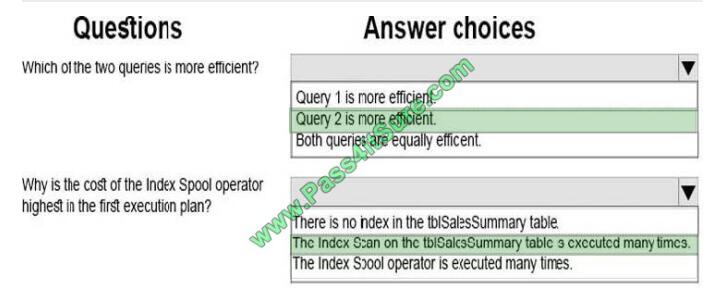Save time!Know which topics, in what order. Let me tell you what to learn about the 70-761 exam.If you want to make your success definite in Microsoft you can use 70-761 dumps for preparation. Using the https://www.pass4itsure.com/70-761.html recommended study materials, you can easily get 70-761 querying data pass the 70-761 exam.
Exam 70-761 : Querying Data with Transact-SQL
What is T-SQL?T-SQL is a proprietary set of programming extensions from Microsoft and Sybase used to interact with relational databases.
The first exam in SQL Server 2016 is Microsoft Exam 70-761. This is the first exam related to Transact-SQL query data, Transact-SQL is the query language used in SQL Server.
Content:
- Manage data with Transact-SQL (40–45%) key
- Query data with advanced Transact-SQL components (30–35%)
- Program databases by using Transact-SQL (25–30%)
learn:
- Manage data with Transact-SQL
- Create Transact-SQL SELECT queries
- Query multiple tables by using joins
- Implement functions and aggregate data
- Modify data
- Query data with advanced Transact-SQL components
- Query data by using subqueries and APPLY
- Query data by using table expressions
- Group and pivot data by using queries
- Query temporal data and non-relational data
- Program databases by using Transact-SQL
- Create database programmability objects by using Transact-SQL
- Implement error handling and transactions
- Implement data types and NULLs
Certification:
More about MCSA certification, maybe you are interested:
Do you have the following doubts about the 70-761 exam?
| Is difficult? | If you have experience with T-SQL, it should not be difficult. |
| Must I attend? | If you want to get Microsoft certification, we recommend that you take this exam first. |
| What is the score to pass? | 700/1000 |
| What other exams are there after passing? | 70-762, 70-764, 70-765, 70-767,70-768 Exam. |
Latest study material for exam 70-761 – Recommended
Recommended – experience
This exam is for SQL Server database administrators, system engineers and developers with two or more years of experience who want to validate their skills and knowledge to write queries.
Recommended – book
These books will help you pass the exam:
- Murach’s SQL Server 2012 for Developers (Training & Reference)
- Itzik Ben-Gan books
- Beginner SQL Programming Using Microsoft SQL Server 2016
- Learn SQL Server Intuitively: Transact-SQL: The Solid Basics
- Working with XML and SQL Server
- Exam Ref 70-761 Querying Data with Transact-SQL
Recommended – videos
Latest MCSA 70-761 dumps Practice test Questions and answers
Recommended – courses
20761: Querying Data with Transact-SQL (three days)
If you prefer a teacher instead of reading a book or watching a video, then it is a good choice to start with.
Recommended – questions and answers(from pass4itsure)
QUESTION 1
You develop and deploy a project management application. The application uses a Microsoft SQL Server database to
store data. You are developing a software bug tracking add-on for the application. The add-on must meet the following
requirements:
Allow case sensitive searches for product.
Filter search results based on exact text in the description.
Support multibyte Unicode characters.
You run the following Transact-SQL statement:

You need to ensure that users can perform searches of descriptions. Which Transact-SQL statement should you run?
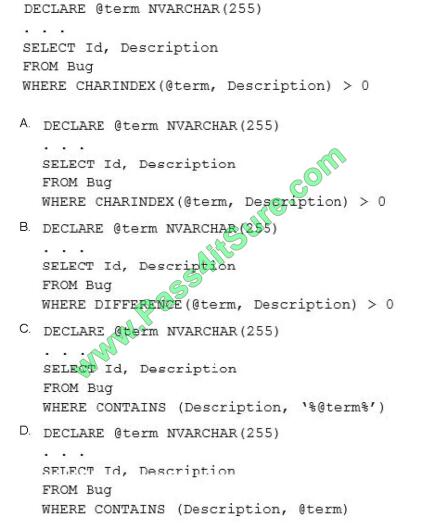
A. B. C. D.
Correct Answer: D
References: https://docs.microsoft.com/en-us/sql/t-sql/queries/contains-transact-sql?view=sql-server-2017
QUESTION 2
Note: This question is part of a series of questions that present the same scenario. Each question in the series contains
a unique solution that might meet the stated goals. Some question sets might have more than one correct solution,
while others might not have a correct solution.
After you answer a question in this section, you will NOT be able to return to it. As a result, these questions will not
appear in the review screen.
You have a database named DB1 that contains two tables named Sales.Customers and Sales.Orders.
Sales.Customers has a foreign key relationship to a column named CustomerID in Sales.Orders.
You need to recommend a query that returns all the customers. The query must also return the number of orders that
each customer placed in 2016.
Solution: You recommend the following query:
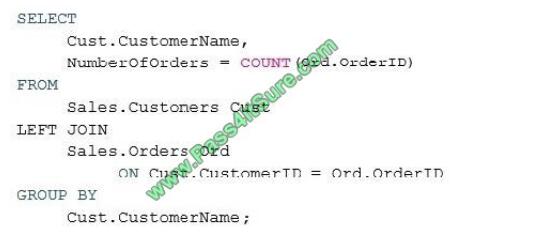
Does this meet the goal?
A. Yes
B. No
Correct Answer: B
QUESTION 3
Note: This question is part of a series of questions that use the same or similar answer choices. An answer choice may
be correct for more than one question in the series. Each question is independent of the other questions in this series.
Information and details provided in a question apply only to that question.
You have a database that contains tables named Customer_CRMSystem and Customer_HRSystem. Both tables use
the following structure:

The tables include the data below: Customer_CRMSystem
 Customer_HRSystem
Customer_HRSystem

Records that contain null values for CustomerCode can be uniquely identified by CustomerName. You need to display
customers who appear in both tables and have a non-null CustomerCode. Which Transact-SQL statement should you
run?
Correct Answer: B
INTERSECT returns distinct rows that are output by both the left and right input queries operator. Incorrect Answers:
A: INNER JOIN returns records that have matching values in both tables but it returns duplicate records.
C: LEFT OUTER JOIN returns ALL records from the left table, and the matched records from the right table.
D: EXCEPT returns distinct rows from the left input query that are not output by the right input query.
E, F: UNION and UNION ALL combines the results of two or more queries into a single result set that includes all the
rows that belong to all queries in the union.
G: CROSS JOIN returns all possible combinations of data from both tables.
H: FULL OUTER JOIN returns all records when there is a match in either left or right table
Note: NULL values are treated as distinct values in join operations.
References:
https://docs.microsoft.com/en-us/sql/relational-databases/performance/joins?view=sql-server-2017
https://docs.microsoft.com/en-us/sql/t-sql/language-elements/set-operators-except-and-intersect-transact-sql?view=sqlserver-2017 https://docs.microsoft.com/en-us/sql/t-sql/language-elements/set-operators-union-transactsql?view=sqlserver-2017 https://www.w3schools.com/sql/sql_join.asp
QUESTION 4
You have a database named DB1 that contains a temporal table named Sales.Customers.
You need to create a query that returns the credit limit that was available to each customer in DB1 at the beginning of
2017.
Which query should you execute?

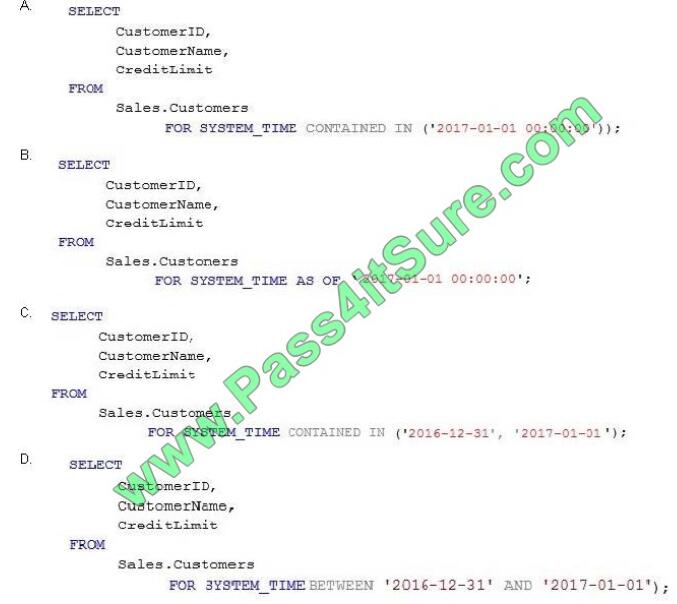
A. B. C. D.
Correct Answer: B
QUESTION 5
DRAG DROP
You have two tables named UserLogin and Employee respectively.
You need to create a Transact-SQL script that meets the following requirements:
The script must update the value of the IsDeleted column for the UserLogin table to 1 if the value of the Id column for
the UserLogin table is equal to 1.
The script must update the value of the IsDeleted column of the Employee table to 1 if the value of the Id column is
equal to 1 for the Employee table when an update to the UserLogin table throws an error.
The error message “No tables updated!” must be produced when an update to the Employee table throws an error.
Which five Transact-SQL segments should you use to develop the solution? To answer, move the appropriate TransactSQL segments from the list of Transact-SQL segments to the answer area and arrange them in the correct order.
Select and Place:
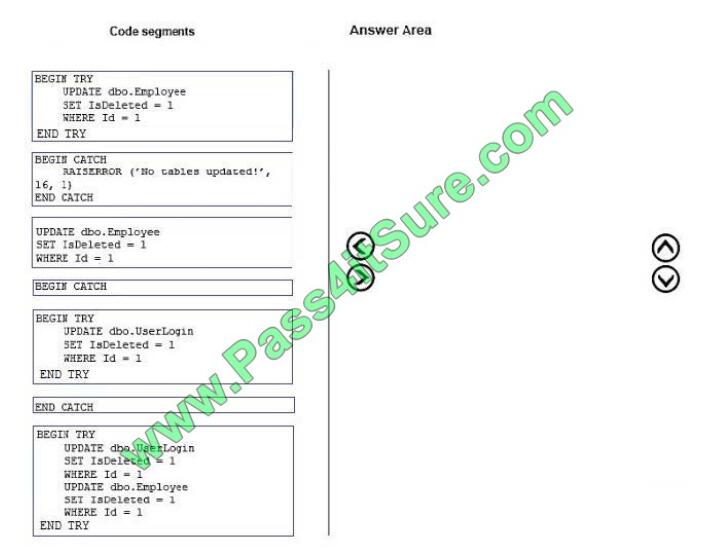
Correct Answer :
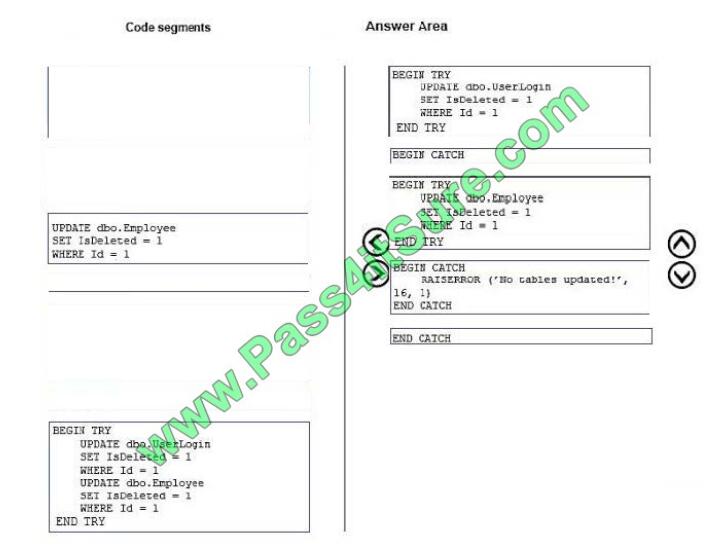
QUESTION 6
HOTSPOT
You have a database that contains the following tables: tblRoles, tblUsers, and tblUsersInRoles.
The table tblRoles is defined as follows.

You have a function named ufnGetRoleActiveUsers that was created by running the following Transact-SQL statement:
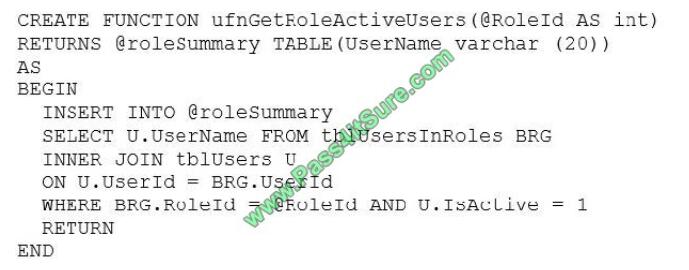
You need to list all roles and their corresponding active users. The query must return the RoleId, RoleName, and
UserName columns. If a role has no active users, a NULL value should be returned as the UserName for that role. How
should you complete the Transact-SQL statement? To answer, select the appropriate Transact-SQL segments in the
answer area.
Hot Area:
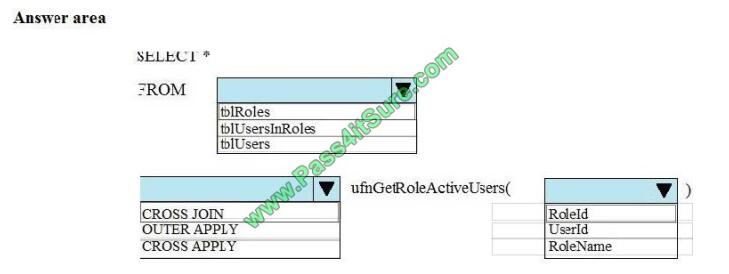
Correct Answer:
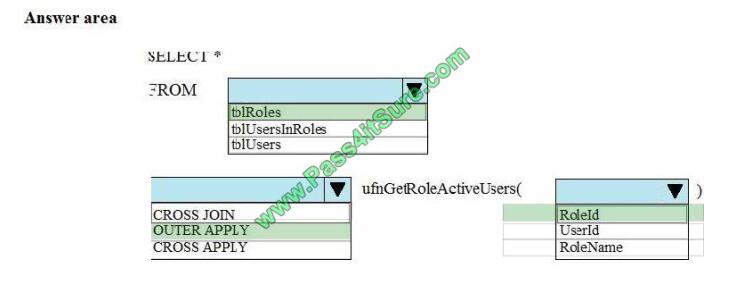
QUESTION 7
Note: This question is part of a series of questions that use the same or similar answer choices. An answer choice may
be correct for more than one question in the series. Each question is independent of the other questions in this series.
Information and details provided in a question apply only to that question.
You have a database that contains several connected tables. The tables contain sales data for customers in the United
States only.
All the sales data is stored in a table named table1. You have a table named table2 that contains city names.
You need to create a query that lists only the cities that have no sales.
Which statement clause should you add to the query?
A. GROUP BY
B. MERGE
C. GROUP BY ROLLUP
D. LEFT JOIN
E. GROUP BY CUBE
F. CROSS JOIN
G. PIVOT
H. UNPIVOT
Correct Answer: D
Reference: https://docs.microsoft.com/en-us/sql/t-sql/queries/from-transact-sql?view=sql-server-2017
QUESTION 8
HOTSPOT
You need to develop a Transact-SQL statement that meets the following requirements:
The statement must return a custom error when there are problems updating a table.
The error number must be value50555.
The error severity level must be14.
A Microsoft SQL Server alert must be triggered when the error condition occurs.
Which Transact-SQL segment should you use for each requirement? To answer, select the appropriate Transact-SQL
segments in the answer area.
Hot Area:
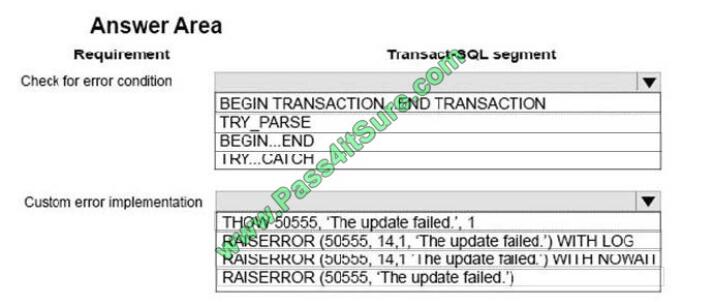
Correct Answer:
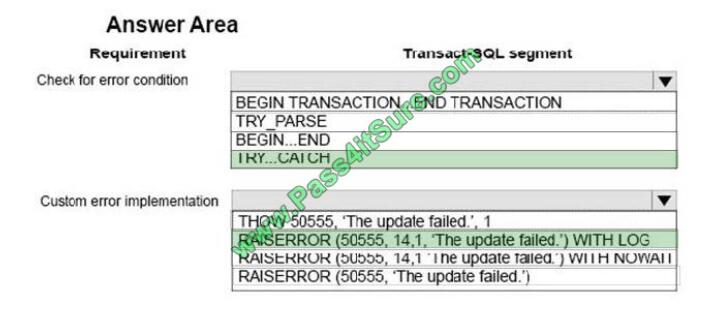
Box 1: TRY…CATCH
The TRY…CATCH Transact-SQL construct implements error handling for Transact-SQL that is similar to the exception
handling in the Microsoft Visual C# and Microsoft Visual C++ languages. A group of Transact-SQL statements can be
enclosed in a TRY block. If an error occurs in the TRY block, control is passed to another group of statements that is
enclosed in a CATCH block.
Box 2: RAISERROR(50555, 14, 1 \\’The update failed.”) WITH LOG
We must use RAISERROR to be able to specify the required severity level of 14, and we should also use the LOG
option, which Logs the error in the error log and the application log for the instance of the Microsoft SQL Server
Database
Engine, as this enable a MS MS SQL SERVER alert to be triggered.
Note: RAISERROR generates an error message and initiates error processing for the session. RAISERROR can either
reference a user-defined message stored in the sys.messages catalog view or build a message dynamically. The
message is returned as a server error message to the calling application or to an associated CATCH block of a
TRY…CATCH construct.
Incorrect Answers:
Not THROW: THROW does not have a severity parameter.
References:
https://msdn.microsoft.com/en-us/library/ms175976.aspx
https://msdn.microsoft.com/en-us/library/ms178592.aspx
QUESTION 9
HOTSPOT
You have a database that contains the following tables: tblEmployees and tblSalesSummary. Each record contains
approximately one million records.
You use Microsoft SQL Server Management Studio (SSMS) to run two queries. The Include Actual Execution Plan
option is enabled.
Both queries return the same results. SSMS generates the execution plans shown in the exhibit. (Click the Exhibit
button.)
You need to troubleshoot the queries.
How should you interpret the execution plans? To answer, select the appropriate options in the answer area.
NOTE: Each correct selection is worth one point.
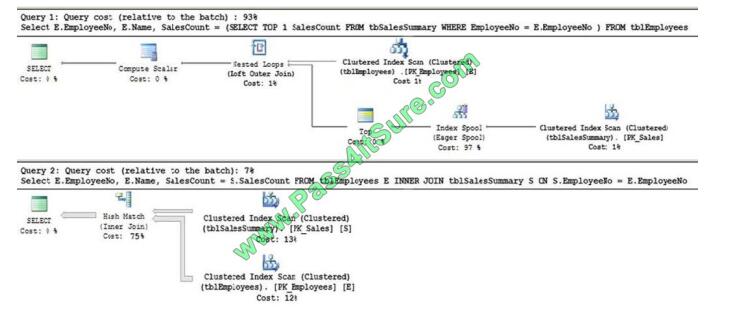
Hot Area:
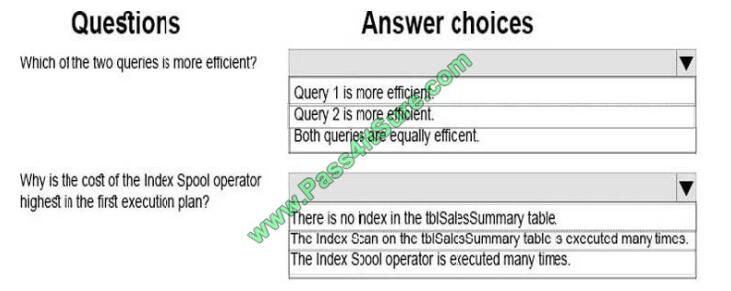
Correct Answer:
QUESTION 10
Note: This question is part of a series of questions that present the same scenario. Each question in the series contains
a unique solution that might meet the stated goals. Some question sets might have more than one correct solution,
while
others might not have a correct solution.
After you answer a question in this section. You will NOT be able to return to it. As a result, these questions will not
appear in the review screen.
You create a table named Customer by running the following Transact-SQL statement:
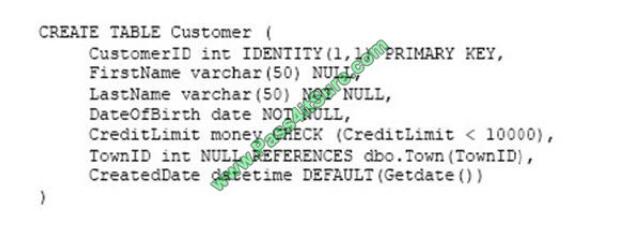
You must insert the following data into the Customer table:

You need to ensure that both records are inserted or neither record is inserted. Solution: You run the following TransactSQL statement:

Does the solution meet the goal?
A. Yes
B. No
Correct Answer: B
Reference: https://docs.microsoft.com/it-it/sql/t-sql/statements/insert-transact-sql?view=sql-server-2017
QUESTION 11
Note: This question is part of a series of questions that present the same scenario. Each question in the series contains
a unique solution that might meet the stated goals. Some question sets might have more than one correct solution,
while
others might not have a correct solution.
After you answer a question in this section. You will NOT be able to return to it. As a result, these questions will not
appear in the review screen.
You have a database that tracks orders and deliveries for customers in North America. The database contains the
following tables:
Sales.Customers
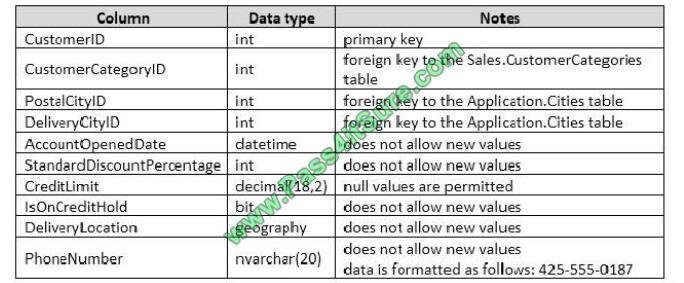
Application.Cities

Sales.CustomerCategories

The company\\’s development team is designing a customer directory application. The application must list customers
by the area code of their phone number. The area code is defined as the first three characters of the phone number.
The main page of the application will be based on an indexed view that contains the area and phone number for all
customers.
You need to return the area code from the PhoneNumber field.
Solution: You run the following Transact-SQL statement:
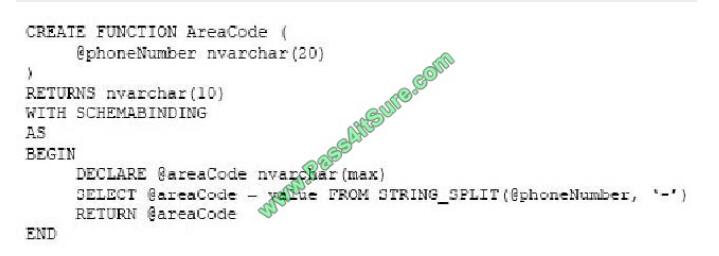
Does the solution meet the goal?
A. Yes
B. No
Correct Answer: B
We need SELECT TOP 1 @areacode =.. to ensure that only one value is returned.
QUESTION 12
You are building a stored procedure that will update data in a table named Table1 by using a complex query as the data
source.
You need to ensure that the SELECT statement in the stored procedure meets the following requirements:
Data being processed must be usable in several statements in the stored procedure.
Data being processed must contain statistics.
What should you do?
A. Update Table1 by using a common table expression (CTE).
B. Insert the data into a temporary table, and then update Table1 from the temporary table.
C. Place the SELECT statement in a derived table, and then update Table1 by using a JOIN to the derived table.
D. Insert the data into a table variable, and then update Table1 from the table variable.
Correct Answer: B
Temp Tables… Are real materialized tables that exist in tempdb Have dedicated stats generated by the engine Can be
indexed Can have constraints Persist for the life of the current CONNECTION Can be referenced by other queries or
subproce Incorrect Answers:
A: CTEs do not have dedicated stats. They rely on stats on the underlying objects
C: Unlike a derived table, a CTE can be self-referencing and can be referenced multiple times in the same query.
References: https://technet.microsoft.com/en-us/library/ms190766(v=sql.105).aspx
https://dba.stackexchange.com/questions/13112/whats-the-difference-between-a-cte-and-a-temp-table
QUESTION 13
HOTSPOT
You develop and deploy a project management application. The application uses a Microsoft SQL Server database to
store data. You are developing a software bug tracking add-on for the application.
The add-on must meet the following requirements:
Allow case sensitive searches for product.
Filter search results based on exact text in the description.
Support multibyte Unicode characters.

You run the following Transact-SQL statement:
Users report that searches for the product Salt also return results for the product salt.
You need to ensure that the query returns the correct results.
How should you complete the Transact-SQL statement? To answer, select the appropriate Transact-SQL segments in
the answer area.
NOTE: Each correct selection is worth one point.
Hot Area:
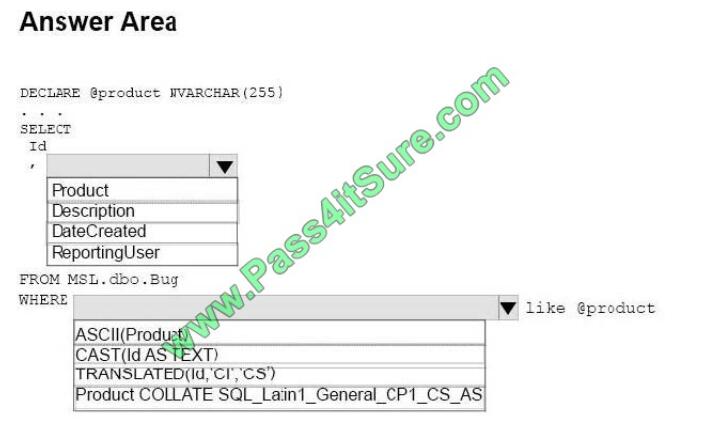
Correct Answer:
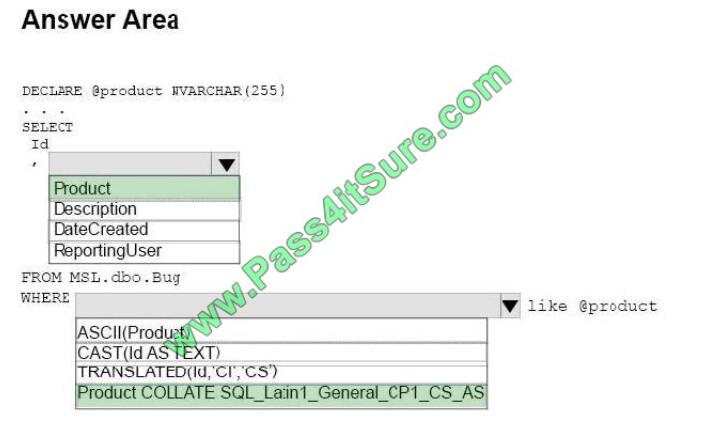
Get latest and Valid Dumps from Pass4itsure
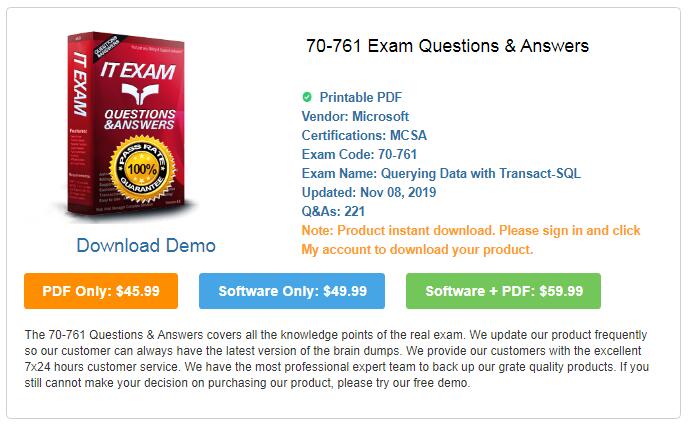
(FREE) Latest 70-761 Dumps From Google Drive: https://drive.google.com/open?id=1FNM7bE-f2LTtpWysfj15-6iutFxJ7rKX
You can easily pass 70-761 exam with the help of the 70-761 study guide provided by Pass4itsure experts.You want to get the latest and valid 70-761 dumps PDF?GO https://www.pass4itsure.com/70-761.html.
